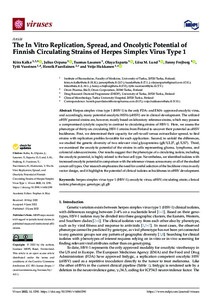The In Vitro Replication, Spread, and Oncolytic Potential of Finnish Circulating Strains of Herpes Simplex Virus Type 1
Esparta Olaya; Lasanen Tuomas; Kalke Kiira; Frejborg Fanny; Orpana Julius; Paavilainen Henrik; Vuorinen Tytti; Lund Liisa M.; Hukkanen Veijo
The In Vitro Replication, Spread, and Oncolytic Potential of Finnish Circulating Strains of Herpes Simplex Virus Type 1
Esparta Olaya
Lasanen Tuomas
Kalke Kiira
Frejborg Fanny
Orpana Julius
Paavilainen Henrik
Vuorinen Tytti
Lund Liisa M.
Hukkanen Veijo
MDPI
Julkaisun pysyvä osoite on:
https://urn.fi/URN:NBN:fi-fe2022081154934
https://urn.fi/URN:NBN:fi-fe2022081154934
Tiivistelmä
Herpes simplex virus type 1 (HSV-1) is the only FDA- and EMA- approved oncolytic virus, and accordingly, many potential oncolytic HSVs (oHSV) are in clinical development. The utilized oHSV parental strains are, however, mostly based on laboratory reference strains, which may possess a compromised cytolytic capacity in contrast to circulating strains of HSV-1. Here, we assess the phenotype of thirty-six circulating HSV-1 strains from Finland to uncover their potential as oHSV backbones. First, we determined their capacity for cell-to-cell versus extracellular spread, to find strains with replication profiles favorable for each application. Second, to unfold the differences, we studied the genetic diversity of two relevant viral glycoproteins (gB/UL27, gI/US7). Third, we examined the oncolytic potential of the strains in cells representing glioma, lymphoma, and colorectal adenocarcinoma. Our results suggest that the phenotype of a circulating isolate, including the oncolytic potential, is highly related to the host cell type. Nevertheless, we identified isolates with increased oncolytic potential in comparison with the reference viruses across many or all of the studied cancer cell types. Our research emphasizes the need for careful selection of the backbone virus in early vector design, and it highlights the potential of clinical isolates as backbones in oHSV development.
Kokoelmat
- Rinnakkaistallenteet [19207]
